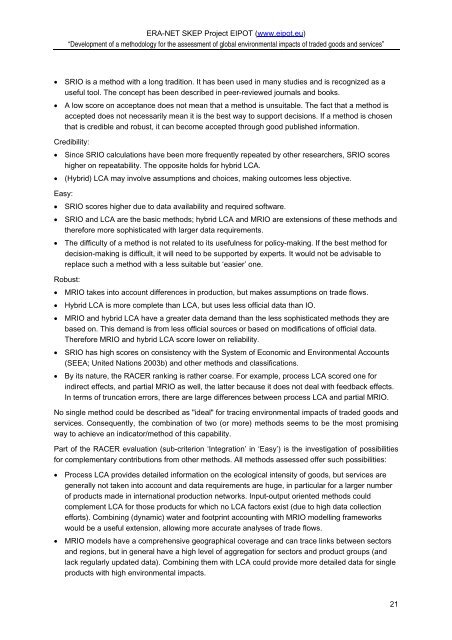EIPOT Final Project Report - Stockholm Environment Institute
EIPOT Final Project Report - Stockholm Environment Institute
EIPOT Final Project Report - Stockholm Environment Institute
You also want an ePaper? Increase the reach of your titles
YUMPU automatically turns print PDFs into web optimized ePapers that Google loves.
ERA-NET SKEP <strong>Project</strong> <strong>EIPOT</strong> (www.eipot.eu)<br />
“Development of a methodology for the assessment of global environmental impacts of traded goods and services”<br />
• SRIO is a method with a long tradition. It has been used in many studies and is recognized as a<br />
useful tool. The concept has been described in peer-reviewed journals and books.<br />
• A low score on acceptance does not mean that a method is unsuitable. The fact that a method is<br />
accepted does not necessarily mean it is the best way to support decisions. If a method is chosen<br />
that is credible and robust, it can become accepted through good published information.<br />
Credibility:<br />
• Since SRIO calculations have been more frequently repeated by other researchers, SRIO scores<br />
higher on repeatability. The opposite holds for hybrid LCA.<br />
• (Hybrid) LCA may involve assumptions and choices, making outcomes less objective.<br />
Easy:<br />
• SRIO scores higher due to data availability and required software.<br />
• SRIO and LCA are the basic methods; hybrid LCA and MRIO are extensions of these methods and<br />
therefore more sophisticated with larger data requirements.<br />
• The difficulty of a method is not related to its usefulness for policy-making. If the best method for<br />
decision-making is difficult, it will need to be supported by experts. It would not be advisable to<br />
replace such a method with a less suitable but ‘easier’ one.<br />
Robust:<br />
• MRIO takes into account differences in production, but makes assumptions on trade flows.<br />
• Hybrid LCA is more complete than LCA, but uses less official data than IO.<br />
• MRIO and hybrid LCA have a greater data demand than the less sophisticated methods they are<br />
based on. This demand is from less official sources or based on modifications of official data.<br />
Therefore MRIO and hybrid LCA score lower on reliability.<br />
• SRIO has high scores on consistency with the System of Economic and <strong>Environment</strong>al Accounts<br />
(SEEA; United Nations 2003b) and other methods and classifications.<br />
• By its nature, the RACER ranking is rather coarse. For example, process LCA scored one for<br />
indirect effects, and partial MRIO as well, the latter because it does not deal with feedback effects.<br />
In terms of truncation errors, there are large differences between process LCA and partial MRIO.<br />
No single method could be described as "ideal" for tracing environmental impacts of traded goods and<br />
services. Consequently, the combination of two (or more) methods seems to be the most promising<br />
way to achieve an indicator/method of this capability.<br />
Part of the RACER evaluation (sub-criterion ‘Integration’ in ‘Easy’) is the investigation of possibilities<br />
for complementary contributions from other methods. All methods assessed offer such possibilities:<br />
• Process LCA provides detailed information on the ecological intensity of goods, but services are<br />
generally not taken into account and data requirements are huge, in particular for a larger number<br />
of products made in international production networks. Input-output oriented methods could<br />
complement LCA for those products for which no LCA factors exist (due to high data collection<br />
efforts). Combining (dynamic) water and footprint accounting with MRIO modelling frameworks<br />
would be a useful extension, allowing more accurate analyses of trade flows.<br />
• MRIO models have a comprehensive geographical coverage and can trace links between sectors<br />
and regions, but in general have a high level of aggregation for sectors and product groups (and<br />
lack regularly updated data). Combining them with LCA could provide more detailed data for single<br />
products with high environmental impacts.<br />
21
















